Pig (feral or wild)
Common name: Pig (feral or wild)
Scientific name: Sus scrofa
Origin: Europe and Asia
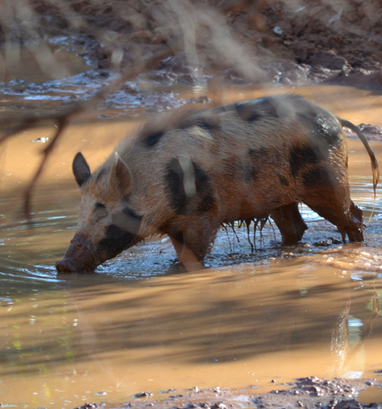
Animal status
In Victoria, pigs (feral or wild) are declared as established pest under the Catchment and Land Protection Act 1994 (CaLP Act).
Read more about the classification of invasive animals in Victoria.
Populations
History of spread
Feral pigs in Australia are descendants of various domestic pig breeds (Sus scrofa), and they have been present since early European settlement. Initially, their populations were concentrated near settlement areas, but they have since spread across 45 per cent of the mainland and occur on several offshore islands. These populations have spread by natural dispersal, accidental escape and deliberate release. Once present, their populations often flourish due to their adaptable behaviour and high reproductive rate.
Distribution in Victoria
Feral pigs are found at several locations throughout Victoria, though their populations are mostly isolated and occur at relatively low densities. Most established populations can be found along the Murray River, far south-west Victoria, the Otway’s, East Gippsland, and parts of central-west and north-east Victoria. New populations continue to emerge as conditions change.
Population density in Victoria
Feral pig densities vary with environmental conditions. In good years, where food, water and shelter are plentiful, their numbers can increase rapidly. While in poor conditions, such as drought, their numbers can decline rapidly as breeding occurs less often and mortality of young is high.
Densities also depend on the habitat type and its productivity. For example, in eucalypt woodland, forests and grazing land, there may be one feral pig per km2, while in wetlands and floodplains there may be as many as 10 to 20 feral pigs per km2.
Animal biology
Established Invasive Animals Best Practice Management video series
1. Controlling feral pigs on your farm in Victoria
Hi, I'm Sam Armstrong and I'm the Victorian Feral Pig Coordinator at Agriculture Victoria. Feral pigs are becoming an increasing threat to biosecurity, agriculture production, and the natural environment within Victoria. This video gives an overview of the species and explores common control methods landholders can use to manage populations.
Feral pigs have been present in Australia since European settlement. They were initially concentrated near settlement areas but have since spread across 45% of the country. It's estimated that there is anywhere between 3.5 to 25.5 million feral pigs in Australia. Though their numbers vary with seasonal changes.
Feral pigs are smaller, leaner, and more muscular than domestic pigs, and they have coarse hair with a straight tail and a bushy tip. They can thrive in a range of environments because of their adaptive behaviour. Though their home range size varies according to resource availability. Sows become sexually mature at around six months of age and can produce two weaned litters of up to 12 piglets in a little over one year.
Feral pigs are opportunistic omnivores that eat many things, including small mammals, birds, reptiles, insects, fruits, seeds, roots, tubers, and foliage. They are also creatures of habit that often live in groups known as mobs. They can range from size from 10 to 50 animals. Feral pigs are relatively heat intolerant and they are highly dependent on water for drinking and wallowing. They also require shaded areas to rest in during the daytime.
Feral pigs cause extensive damage to agriculture and the environment in Victoria. It's estimated the cost to agriculture is more than a hundred million dollars per year loss to production. They are also a major threat to the survival of a number of native species and could spread exotic diseases such as foot and mouth disease and African swine fever in the event of an outbreak.
Identifying feral pig activity is the first step in managing feral pigs on your land. Signs of feral pigs include ground rooting, mud rubs, wallows, tracks, dung, fence crossings, and consumption of carcasses. Familiarise yourself with these signs and keep a lookout for when monitoring your property. Once you've confirmed feral pigs are active in your area, it's then important to develop a strategic plan to manage them.
Control options available for managing feral pigs include baiting, trapping, aerial shooting, ground shooting, and fencing. We'll cover some of these methods in more details in the other videos in this series.
Feral pigs are found in several areas across Victoria, so it's important that we all play our part in managing their populations. Keep a look out for signs of feral pigs on your property and when they are detected, control them with an integrated approach using a range of control options. Watch the other videos in this series. To find out more information, refer to the Agriculture Victoria website or get in touch with the Customer Service Centre. Thanks, and we hope you find these videos helpful.
Appearance
Feral pigs are smaller, leaner and more muscular than domestic pigs. Their shoulders and necks are also more developed and their hair is more sparse, long and coarse.
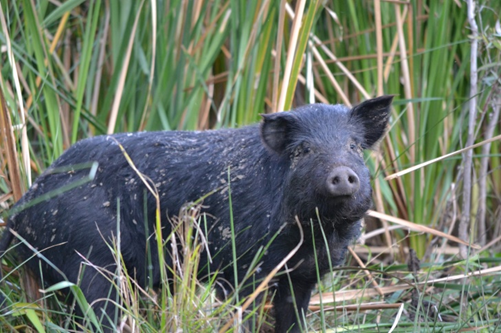
Black is the most common hair colour, though they can also be rusty red or mixed colours, including white, light ginger, brown and white, brown with black spots, brindle and agouti (brown or black with a lighter tip). Piglets are sometimes marked with dark longitudinal stripes that disappear as they grow older.
Feral pigs also have longer snouts and tusks, smaller ears, and straight tails with a bushy tip. Importantly, all pigs have small eyes and poor eyesight, but their senses of smell and hearing are well developed.
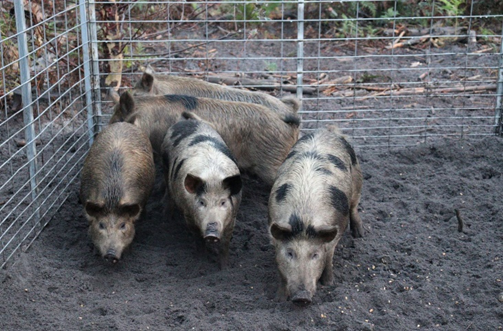
Males and females differ in size and weight, with male feral pigs being longer, taller, and heavier than females of the same age. The weight of an average adult female feral pig is 50 to 60 kg, while males usually weigh 80 to 100 kg. However, this weight can vary with habitat conditions and exceptional animals have reached up to 260 kg in other parts of Australia.
Behaviour
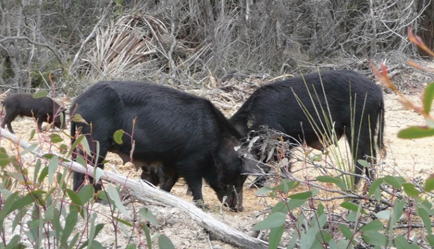
Feral pigs are primarily nocturnal with most activity occurring from dawn to dusk. They are also shy animals and will avoid humans, especially if they are regularly hunted or disturbed, making it easy to overlook their presence or drastically underestimate their numbers.
Feral pigs have defined home ranges. The home range of adult boars can vary between 10 to 50 km2 depending on the habitat/environmental conditions, while an adult sow's home range can be between 10 and 20 km2.
Lactating sows have restricted ranges of less than 5 km2. When a feral pig population has an adequate food supply in its home range, it is unlikely that individuals will travel more than 5 km outside that area.
Feral pigs must have daily access to water and wallowing sites, particularly in hot conditions. They will also use regular trails to travel to water from bedding or feeding areas. Along these trails they often rub on trees or logs, and wallow in mud or dusty depressions. These habits help to reduce infection through managing parasites and skin health, while mud and dust also aids in body temperature regulation.
A group of feral pigs is often referred to as a 'mob' or 'sounder', which typically consists of related sows (mother, daughters, sisters, aunts, etc.) and their young. Bachelor mobs of sexually mature males form when they leave or are chased from their mother's group. At about 18 months, males become more solitary and will re-join the female groups only for the purpose of mating..
Mob size varies depending on the season and habitat. In forested areas mobs rarely exceed 12 animals, while in more open country, mobs of up to 40 to 50 pigs may form.
Diet
Being omnivorous, feral pigs will feed on almost anything and will readily switch foods depending on its availability. Succulent green vegetation is their food item of choice, but they will eat fruit, grain and a wide variety of animals. Feral pigs will also eat underground plant materials such as roots, bulbs, corms, and fungi. They have been known to predate on new-born lambs.
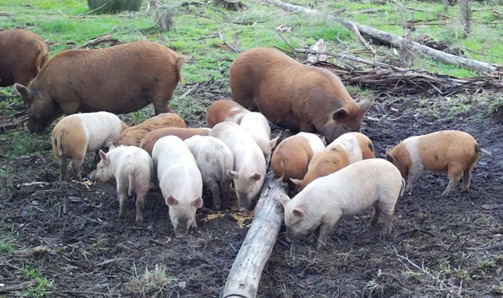
As feral pigs require high energy or protein-rich food, they often impact on agriculture as they destroy crops. However, this need is also a weakness in their ecology that can be exploited for management purposes.
Preferred habitat
Shelter is vitally important for feral pigs as it provides them with shade and protection from predators. Feral pigs typically prefer to live in moist environments that can provide a reliable and adequate food and water supply.

In Australia, feral pigs are found in a wide range of habitats including:
- rainforest areas
- monsoon forest
- paperbark swamps
- open floodplains
- marsh areas
- semi-arid floodplains
- dry woodlands
- subalpine grasslands
- forest.
Because feral pigs need to drink daily in hot weather, they are generally not found in the dry inland areas of Australia.
Predators
Feral pigs are prone to predation by dingoes and large birds of prey.
Diseases and parasites
Feral pigs can be hosts or vectors of numerous endemic parasites and diseases, some of which can affect animals or people. They are also potential carriers of exotic diseases, with the biggest concerns being Foot-and-Mouth Disease and African Swine Fever should they ever enter Australia.
Endemic and exotic diseases that have the potential to devastate commercial pig operations, as well as infect other animals and humans include:
- Foot-and-Mouth disease
- Japanese encephalitis virus
- African swine fever
- Leptospirosis
- Brucellosis
- Melloidosis
For more information on these diseases, see https://agriculture.vic.gov.au/biosecurity/animal-diseases
Reproduction
Feral pigs do not have a defined breeding season and can breed throughout the year, although breeding success depends on the availability of quality food.
Sexual maturity in sows depends on weight rather than age, like domestic pigs. A sow may begin breeding from about six to eight months of age, when her weight exceeds about 25 to 30 kg. Sows have a 21-day oestrus cycle and a gestation period of 112 to 114 days. Average litter sizes vary from 5 to 6 piglets, but up to 12 piglets can be born under good conditions. Boars become sexually mature from about 18 months of age.
Just before giving birth, sows will often make a nest using available vegetation. Piglets will normally spend the first one to five days of their life inside the nest, with the sow inside or close by. The nest is usually less than 2 km from available water.
A feral pig litter is weaned after two or three months, at which time mating can occur again. Under favourable conditions, a sow can produce two weaned litters in little over a year, thus feral pigs can multiply at a very fast rate. This breeding capacity also allows feral pig populations to quickly recover from natural setbacks (drought) or control programs.
Impact
Impact on ecosystems and waterways
Feral pigs are considered an environmental pest due to their selective feeding, trampling and rooting for plants and invertebrates. They also compete with native wildlife for food, water, shelter and prey directly on various wildlife species and their eggs. Predation, habitat degradation, competition and disease transmission by feral pigs have been listed as a key threatening process to threatened species conservation under the Environment Protection & Biodiversity Conservation Act 1999.
Feral pig activity also has a dramatic effect on watercourses and swamps. By wallowing and rooting around the waterline, they destroy the riparian vegetation which provides food and nesting sites for native wildlife and helps to prevent soil erosion. Water quality is also affected, and their diggings may spread undesirable plant and animal species, and plant diseases in these areas.
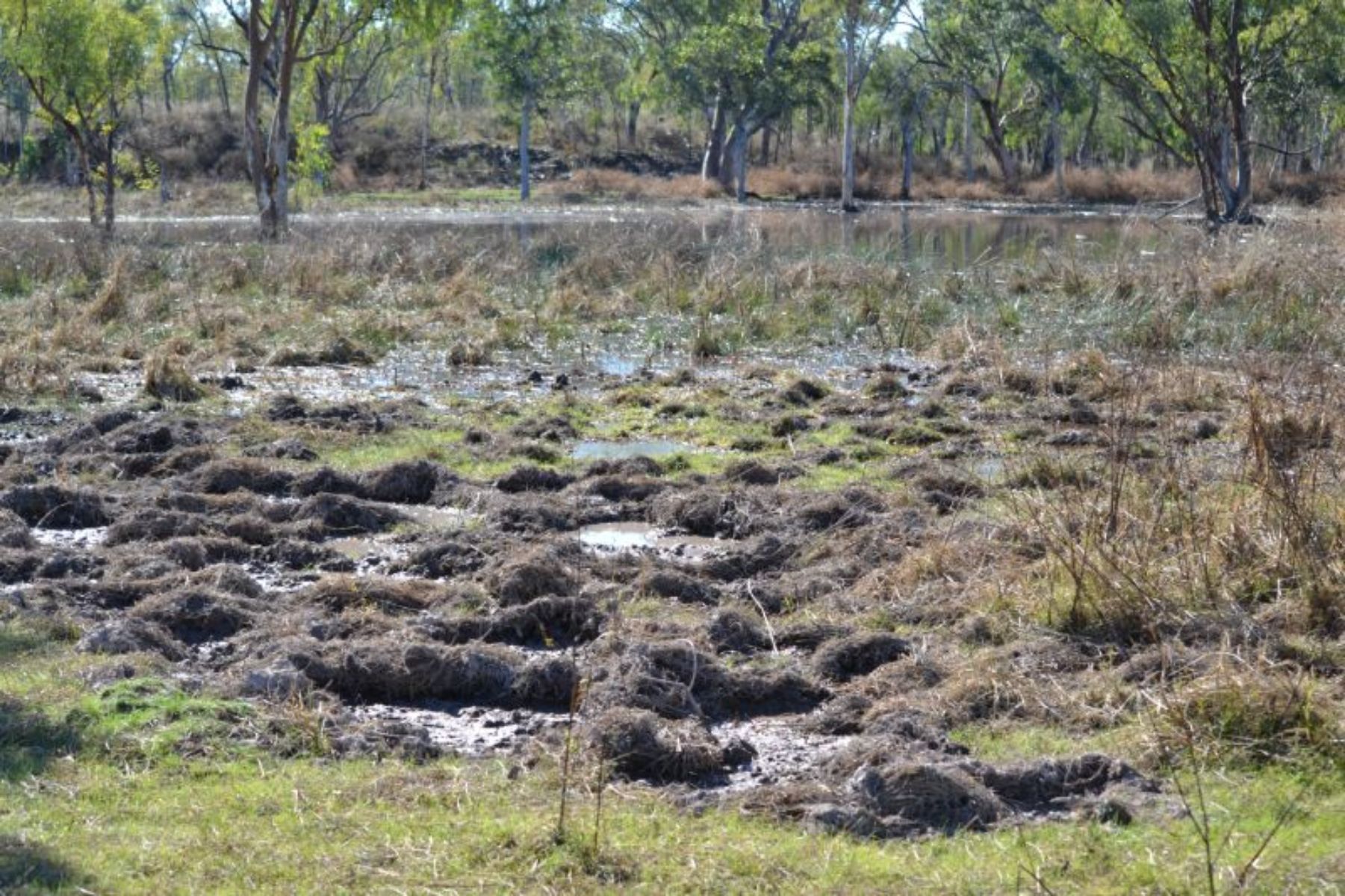
Agricultural and economic impacts
Feral pigs cause significant damage in agricultural areas. They prey on newborn lambs, compete with livestock for pasture and can damage infrastructure such as fencing and water facilities. Feral pigs impact grain, sugarcane, fruit and vegetable crops, through uprooting and consuming or trampling of plants, and their wallowing and defecation fouls dams and waterholes. Feral pigs can also transport weeds and ground rooting provides ideal conditions for weed establishment.
Feral pigs impact grain, sugarcane, fruit and vegetable crops, through uprooting and consuming or trampling of plants, and their wallowing and defecation fouls dams and waterholes. Pigs can also transport weeds, with ground rooting providing ideal conditions for weed establishment.
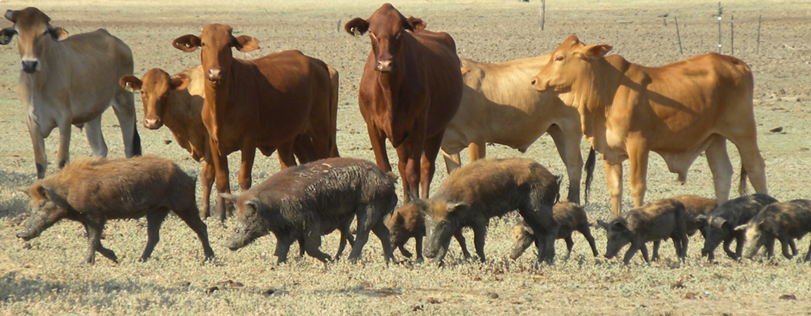
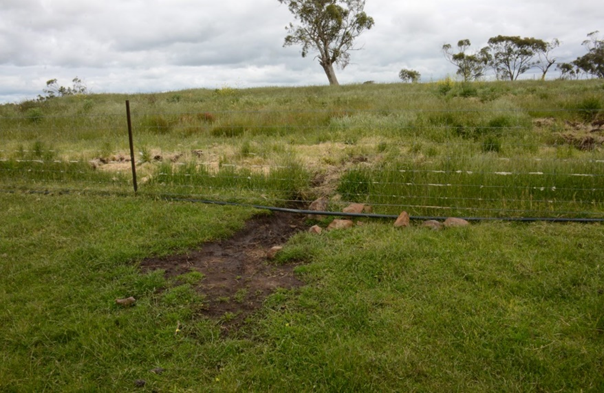
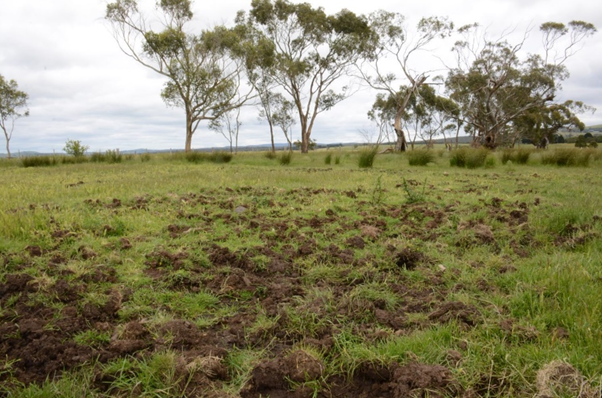
Social values and health
Feral pigs can be seen as a food and a valuable hunting resource to some members of the community. However, it is important to remember the damage caused by feral pigs to agriculture, the environment, cultural heritage, and their ability to carry and spread disease far outweighs any potential benefits.
Management
Recommended control measures include:
- baiting
- trapping
- aerial shooting
- ground shooting
- exclusion fencing
The department recommends integrated pest management using all suitable control tools implemented in a coordinated manner on a landscape scale.
Read more about Integrated feral pig control.
Further reading
- Animal Control Technologies 2004, Feral Pig Problems in Australia, Animal Control Technologies, viewed online 16th March 2010
- Centre for Invasive Species Solutions, 2011. Feral pig biology, ecology and behaviour. Factsheet. PestSmart website. Accessed 26 April 2022
- Choquenot, D, McIlroy, J and Korn, T 1996, Managing Vertebrate Pests: Feral Pigs, Bureau of Resource Sciences, Australian Government Publishing Service, Canberra. Record accessed online 26 April 2022
- Croft, D 2007, Vertebrate Pest Control Manual: Feral pig biology and control. State of New South Wales, NSW Department of Primary Industries.
- Department of the Agriculture, Water and the Environment 2011, The feral pig (Sus scrofa), fact sheet, viewed 26 April 2022
- Invasive Animals CRC, The feral pig (Sus scofa), viewed 16th March 2010.
- Land Protection (Invasive plants and animals) 2008, Feral pigs in Queensland – distribution, ecology and impact, fact sheet, The State of Queensland, Department of Primary Industries and Fisheries.
- McGaw, C.C and Mitchell, J 1998, Pest Status Review Series: Feral Pigs (Sus scrofa) in Queensland, Department of Natural Resources and Mines, QLD
- Mitchell, J 2008, Feral Pig Control – A practical guide to pig control in Queensland, The State of Queensland Department of Primary Industries and Fisheries.
- Queensland Government Department of Natural Resources and Mines 2005, A guide to pest animal management in Queensland – Vertebrate pest manual, The State Government of Queensland, Queensland, Australia.
- Regan, K 2002, Landcare Notes: Feral pigs in Victoria, LC0306, Department of Primary Industries, State Government of Victoria.
- West, P 2008, Assessing Invasive Animals in Australia 2008. National Land & Water Resources Audit and Invasive Animals CRC, Canberra. Accessed online 26 April 2022
Image credits
Figures 1–10 courtesy of Jason Wishart, Sam Armstrong & Nigel Roberts